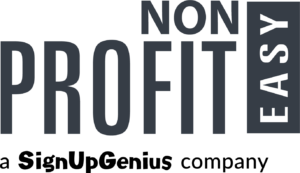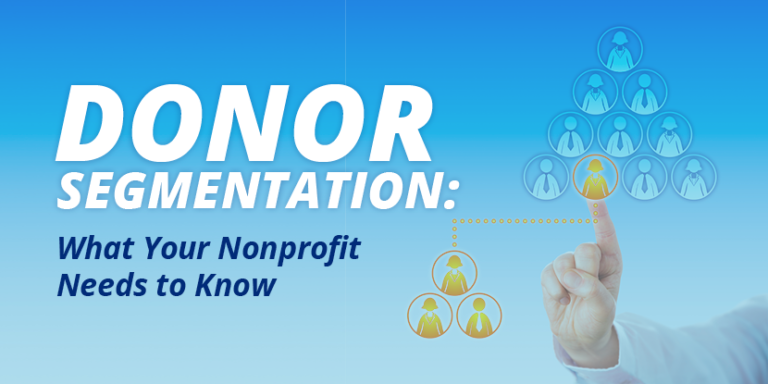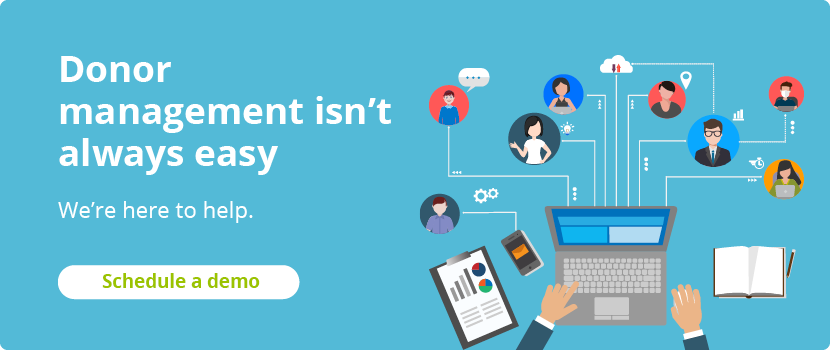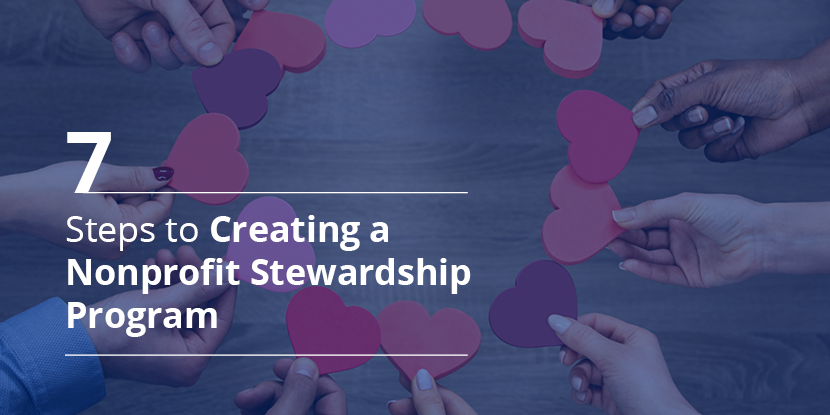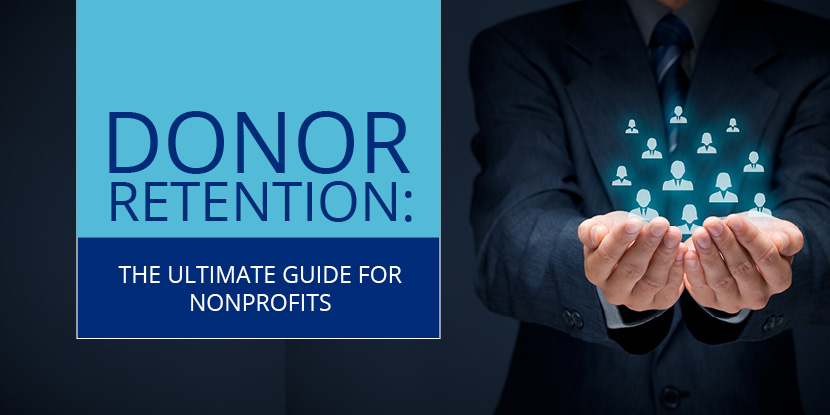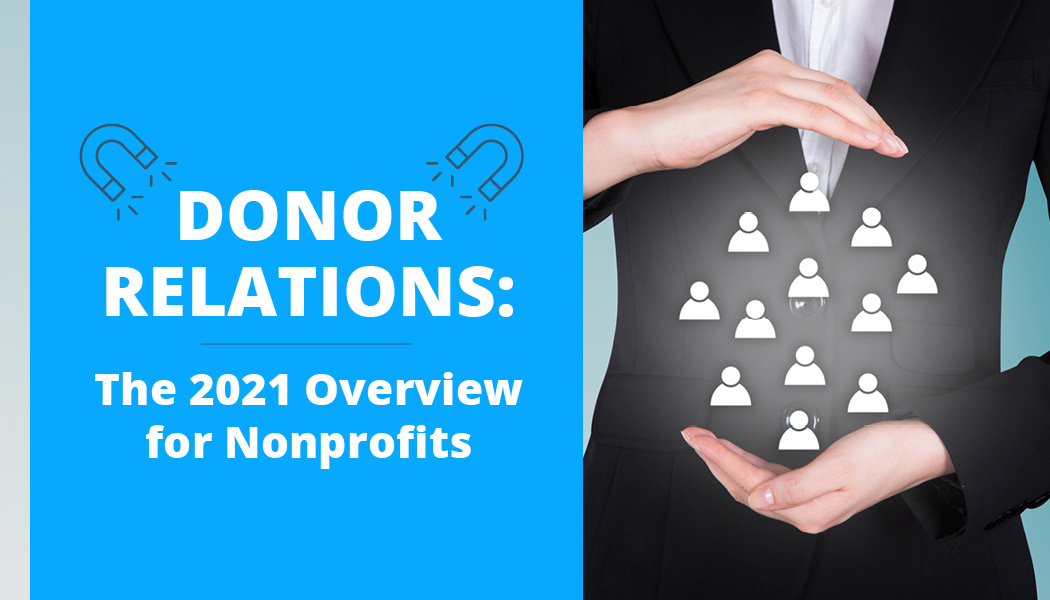Your nonprofit already knows that each of your donors is an individual with unique passions and interests. So why would you communicate with your donor population like they’re all the same? While sending each donor their own letter or email every time you reach out is an impossible dream, it’s not impossible to target your communications more effectively.
Donor segmentation allows you to provide the kind of specific, personal communications that satisfy donors and lead to more donations. Instead of trying to connect with your whole donor population with one generic and uninspiring email campaign or letter, segment your donors into smaller, more homogeneous groups.
When you split your donors into groups based on similarities, you can tailor your communications to their interests and preferences, which inspires them to get more involved. This may seem like a complex undertaking, but it doesn’t have to be!
We’ve created this guide for you to learn about donor segmentation and apply it to your own nonprofit. Keep reading to get started, or use this table of contents to jump to the most important section for you:
- What Is Donor Segmentation?
- Why Should You Segment Your Donors?
- How Do You Segment Donors
- 4 Donor Segmentation Best Practices
If you’re ready to learn more about donor segmentation and how it can help your nonprofit, read on!

What Is Donor Segmentation?
Donor segmentation is a strategy through which a nonprofit splits its donor population into smaller groups or segments based on similarities in giving preferences, communication preferences, or other factors.
Donors come from various places, give different amounts of money, and donate on all sorts of schedules. These segments are influenced by their location, generational grouping, education level, and more.
You may segment your donors by communication preference and then find additional similarities among those who prefer to be emailed, such as retirement status or giving method preferences.
Every nonprofit will segment differently, as art museum fundraising differs from fundraising for summer camps, but segmentation is helpful for everyone. Grouping similar donors together will take time, but the hard work will pay off. Your communication efforts will be more successful when the recipients of your efforts feel as though you’ve taken the time to get to know them.

Why Should You Segment Your Donors?
Imagine you’re a donor receiving an email from a nonprofit. You wouldn’t like to receive an email that starts like this:
To Whom It May Concern,
It may make you feel like the nonprofit doesn’t care about you, only your wallet. Instead, imagine getting a letter that starts like this:
Dear Maxime,
Just using a donor’s preferred name, not to mention including relevant opportunities, goes a long way toward building strong donor relations and increasing donor engagement.
Donor segmentation allows nonprofits to send personalized communications, which donors want.
With segmentation, you can send donors the information that’s relevant to them and avoid bombarding them with irrelevant messages. For example, you wouldn’t want to send long-time donors emails meant for supporters new to the organization. Similarly, you wouldn’t want to send every volunteer update to those people who never volunteer.
It might seem like a hassle to send emails with different content to different segments of your donor population. Still, the numbers show that organizations that take the time to personalize their donation requests receive more gifts, bigger gifts, and more frequent gifts.

How Do You Segment Donors?
Segmenting a mass of donors into manageable groups requires a systematic approach. You’ll begin by grouping donors according to the category that matters most to your organization. Within these groups, form additional subgroups according to your second most important donor trait until you’ve segmented donors to your satisfaction. You could, and should, end up with a lot of segments.
How donors are segmented, however, will vary according to what is most important to any individual nonprofit. You can segment donors by:
- Demographics.
- Donation history.
- Preferred communication method.
- Desired information.
Because this can be an overwhelming amount of data, consider leveraging donor management software, such as NonProfitEasy, to help you more effectively segment and communicate with donors. As a first step, we’ve detailed below how your organization might utilize each of these categories
Demographics.
The specific details of donors vary according to many categories, many of which are simply general demographic categories:
- Age
- Gender
- Income level
- Location
You can use this information in a variety of ways. For example, knowing where your donors work can help you segment them to reach out about matching gifts.
Additionally, it may help to group donors according to their generational designations. For instance, fundraisers need to employ different strategies to get through to millennials than they do to land donations from baby boomers.
There are also demographic categories that are more specific to nonprofits. These pertain to a donor or prospect’s level of involvement with your organization:
- Staff members
- Volunteers
- Board members
- Donors
- Advisers
The length of your relationship with the donor and their level of engagement with your organization also matter to your segmentation strategy.
A person who has been involved with your nonprofit for a longer time requires different communications than someone who just volunteered for the first time. Segmentation can be a lot to think through, but never forget that personalization is the key to a donor’s heart.
Donation history.
Whether you’re soliciting new donors or identifying people who have given multiple gifts over many years, donation data matters. Segment donors based on recency, frequency, and money donated:
- Recency. When was the last time this person donated? Yesterday? Three years ago? Never?
- Frequency. How often are donations made? Once a year? Once a month? Has this person never donated before?
- Money donated. What is the total amount donated to your nonprofit from all gifts given by this donor?
You can make segments according to how recently people donated and the amounts of their donations. People who gave $25 a year ago require different solicitation than donors who contributed $500 three months ago.
Similarly, donors who are known to give more frequently, such as every couple of months, should be contacted more often than donors who have been giving once a year for multiple years.
Communication frequency matters because sending too many emails or calling too often can irritate donors and cause them to pull away from your organization. People are more likely to accept your donation requests when they come at the right times.
Preferred communication method.
Communication methods vary, and knowing what donors prefer can go a long way toward landing donations. Consider segmenting your donors by the following communication preferences:
- Direct mail
- Phone
- Events
- Social media
One type of communication, however, might not be enough. Some donors will be receptive to and require both phone calls and in-person conversations. Communication strategies can be mixed and matched as needed. Success hinges on knowing what your donors want and what they respond to best in any situation.
Desired information.
Aside from donation information, your nonprofit can also share updates about special events, programs, the impact of your organization, and other topics.
In fact, many donors will want this information in addition to your solicitations. Donation requests can be made in tandem with other communications.
Sometimes followers only want communications devoid of solicitations, and that’s okay! Just because someone does not wish to donate today does not mean they won’t want to give tomorrow.
Because the information that will convince people to donate differs according to what inspires them and their affiliation with your nonprofit, you may also choose to create segments based on the types of information they want to receive.
Acquiring donors can be a long process. If you’re patient, give prospects what they want, and inform them about the parts of your organization that they care about most, you stand a good chance of turning these supporters into donors.

4 Donor Segmentation Best Practices
Now that we’ve explored the different ways to segment your donors, let’s break down the best practices of donor segmentation and data management.
1. Assign meaningful donor segments.
You might think that segmenting takes you from an overwhelming amount of donors to an overwhelming number of groups, but that’s not true. It’s much easier to retrieve a single file from an organized binder than to find a needle in a haystack.
A database organized according to segments makes fundraising more efficient, saving time that fundraisers can dedicate to actually talking to donors.
Meaningful segments should organize donors into searchable categories that allow you to quickly search and find certain kinds of donors. For example, you might look for major gift donors or donors who prefer their solicitations through direct mail. When you pull up a specific donor’s profile, you should be able to easily identify if you’re looking at an annual donor versus a lapsed donor, and how to contact this donor according to their designated preferences.
When you organize your groups according to calculated, defined criteria, you end up with donor clusters that you understand and for which you can form specific communications strategies.
2. Create unique strategies for different donor segments.
Different donors require different ask strategies. But before you start sending everyone in your database a personalized ask, let’s consider the difference between donors and records:
- Donors are people who have previously donated to your organization.
- Records are the individual files you have on donors, volunteers, and others associated with your nonprofit.
Records don’t necessarily equate to donors. They’re simply the people and organizations your nonprofit has somehow come into contact with and acquired information from. While some records are for people who merely signed up for your online newsletter, others are for donors.
The difference between records and donors highlights how segmentation improves ask strategies. Donor segmentation helps you to group people according to the type of donation that you should ask for—and how you should make that request.
We can break down personalization in a number of ways:
Amount.
Ask for too little and you won’t get as much as you could. Ask for too much and you might offend the donor. For example, a person who your nonprofit only knows because she signed up for your online newsletter likely doesn’t require or want a major gift appeal. Any gift she gives would make her a first time donor. Thus, you want to ask for an appropriate amount.
When you break up donors according to how much to ask for, updating communications can be as simple as pasting a new ask amount into a solicitation letter or remembering to request a certain amount during your next phone call. It’s about paying attention to what donors have and respecting how much they’d like to give at present.
Impact.
Donors want to feel like their donation matters, but not every donor will want their donation to matter in the same way. Many people may only be interested in a specific program or event that your nonprofit offers. In a donor’s profile, you should keep track of which campaigns they give to, so that you know what issues inspire them to give. Then, tailor your ask to focus on the impact their donation will have on that program or event.
Personal information.
Finally, address your donors directly. Every ask you make should be addressed specifically to each individual donor. At the very minimum, use their name, pronouns, and preferred title. You can leverage merge tags to automatically include this information across all of your outreach—from text messages to emails to direct mail.
Personalizing communications satisfies each segment of donors. Make sure you’re always giving them the information they need in order to avoid donor drop-off.
3. Analyze engagement by donor segments.
Along the way, keep track of how donors are responding to your outreach strategies. Look for patterns and trends among specific segments. For instance, if very few of your large donors opened or gave to an email campaign, you’d want to consider approaching them via a different channel.
Though the final metrics you choose to measure will depend on your audience and the strategy you choose, you might track:
- Link clicks
- Email open rates
- Donation amount
- Donation frequency
- Event attendance
- Hours volunteered
- Survey responses
- Page views
All of these data points can be easily stored, accessed, and analyzed with an organized donor database. With this information, you can have a better idea of how your communications strategy is working for a given segment and make adjustments for the future.
4. Regularly reexamine your lists.
An enemy is lurking, patiently waiting to destroy all your hard work, and that villain is data integrity.
Simply put, inaccurate data is useless. Inaccuracies can occur due to obtaining information via poor methods, using unreliable sources, or failing to track information as it is learned.
If you don’t have the correct data about your donors, you risk making serious missteps with them and hurting your relationship. For instance, if you don’t have the right address, and they only respond to direct mail, you’ve lost contact with that donor. If you call a donor by the wrong name or spell their name the wrong way, they’ll think that your organization does not care about them.
But the other side to data integrity is being able to actually use the information in your database. As your nonprofit evolves, your donors and their donation profiles will change, too. Your initial donor segments may become outdated. Making fundraising appeals to segments that no longer apply to your segments, especially as giving histories and key demographics change, can put you at a disadvantage.
Ultimately, donor segmentation should make it easier to understand your donors. In order to make the most of your donor segments, conduct regular assessments of your segmentation processes. Leverage your engagement data to improve and tailor your communication efforts and create new or adjust existing segments in a more effective way.
Additional Resources
Donor segmentation, while important, is only one piece in the donor engagement puzzle. For more information on connecting with donors and improving your fundraising strategy overall, check out a few of our favorite additional resources:
- Donor Database Buyer’s Guide: How to Choose Your Software. Not sure which software to use for your donor segmentation. Use this in-depth review of donor databases to help guide your decision.
- Donor Retention: The Ultimate Guide for Nonprofits. Don’t let your donor segmentation go to waste! Follow this guide to put your newfound donor segmentation skills to use to retain and engage your donors.
- 7 Steps to Creating a Nonprofit Stewardship Program. Creating a foolproof stewardship strategy requires more than just a great idea. Follow these seven steps to build a stewardship plan with the future in mind.
